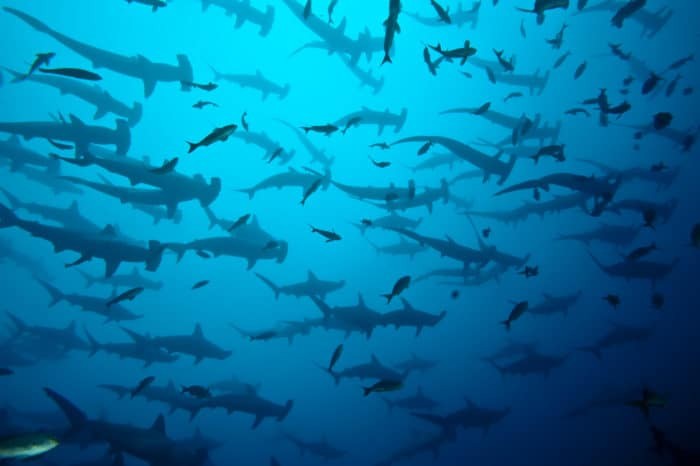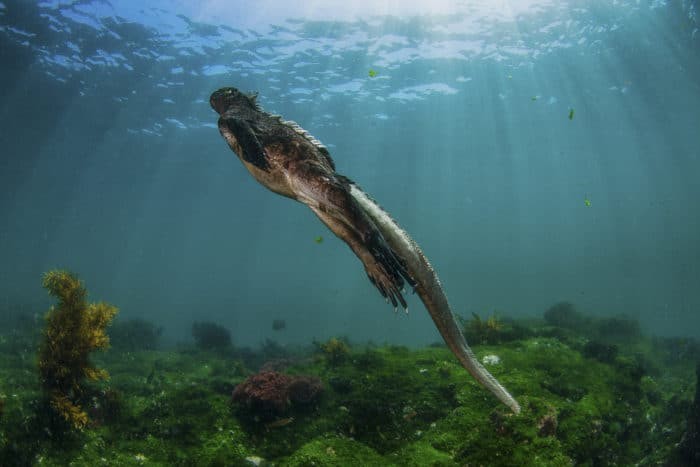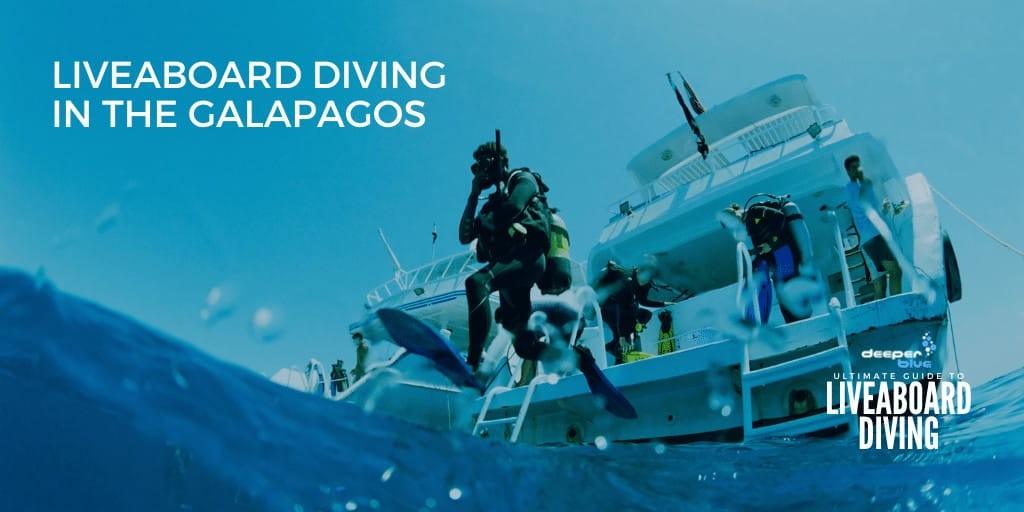Galapagos Liveaboard Diving is part of the Ultimate Guide to Liveaboard Diving
This page contains references to products from one or more of our advertisers. We may receive compensation when you click on links to those products. For an explanation of our Advertising Disclosure Policy, visit this page.
Galapagos is notoriously one of the best destinations in the world for encountering large and rare marine life!
The islands that renownedly inspired Charles Darwin’s theory of evolution are any nature lover’s haven today. It is home to many birds and animals that are endemic to the Galapagos islands, so it shouldn’t be a surprise that the Galapagos Marine reserve is a UNESCO World Heritage site and is an area that falls under strict protection.
The Galapagos Archipelago is situated 900km west of mainland Ecuador; it’s made up of 13 major islands and 100 islets right at the junction of three ocean currents; with cold water arriving from the southeast, the subsurface equatorial undercurrent pushing cold water from the deep; and the Panama current bringing warm water from the northeast, it only makes sense that Galapagos is an oasis for a vast range of marine ecosystems and fish populations!
Galapagos Liveaboard Routes
The Galapagos islands offer over 70 dive sites to explore! Let’s look into some of the more popular routes.
Check Prices on Galapagos Liveaboards
Wolf & Darwin
Wolf and Darwin’s islands lie in the northwestern part of The Galapagos islands, the most isolated islands of the Galapagos, and can only be reached by liveaboard. Being so highly protected and remote means you can expect pristine diving conditions and the opportunity to encounter scalloped hammerheads on their way to the Cocos, silky sharks, Galapagos sharks, and Manta rays!
Other species you can encounter are spotted eagle rays, dolphins, and, within the correct seasonality, the biggest fish in the world, the whale shark!

Cabo Marshall
Cabo Marshall is located on the North East coast of the Isabella islands; it is also the biggest of the Galapagos islands and is only accessible by liveaboard. It is right below wolf volcano, which remains active, and its most recent eruption occurred in 2015. Luckily this eruption was not as severe as expected, yet, the wildlife in this area remains threatened by volcanic activity. It is home to the rare and endemic pink iguana and colonies of sea lions, turtles, and sea birds.
Deep drop-offs and plateaus characterize Cabo Marshall’s diving, making it the optimal location for Manta Rays to stop and get clean from the resident cleaning wrasse. It’s considered a perfect location for shoals of rays, such as Mobula rays, in particular, be sure to keep an eye above you in the blue to see them!
Cabo Douglas
Cabo Douglas is located on the Eastern side of Fernandina Island.
While diving in the Galapagos generally runs deep, divers here are shallow and often above 26 meters. Here you can encounter the endemic marine iguanas and watch as they dive for up to ten minutes to feed on the algae growing on the rocks. Here you can also find Galapagos penguins, flightless cormorants, and seahorses!
It is the perfect dive site if you are looking to dive with unique species!

Galapagos Seasonality
When planning your Galapagos liveaboard, it is advised to focus more on the seasonality than the route available routes.
- December – May is the wet (Winter) season; the weather is often calm, and water temperatures are between 20°C-26°C.
- July – November is the dry (Summer) season, and sea conditions can be choppier with higher swell and water temperatures between 18°C-23°C.
The optimal seasonality for animal encounters in The Galapagos are:
- Jan-May: Hammerheads
- Dec-May: Manta Rays
- June – Nov: Whale sharks
Marine Encounters While On Galapagos Liveaboards
The main reason why The Galapagos is such a popular destination among adventurous divers is due to the big schools of Scalloped hammerheads, yet, other shark species can be encountered too, such as Galapagos and whale sharks.
Other animals that are popularly encountered on dives in The Galapagos are sea lions, penguins, eagle rays, and big schools of pelagic fish.
Types Of Galapagos Liveaboards
In The Galapagos, you will mainly find single-hull expedition-type motor yachts. These boats are highly seaworthy and can make long voyages in all weather conditions while providing optimal comfort for guests on board.
Liveaboards in The Galapagos include spacious decks for relaxing, a well-set-up dive deck, and comfortable inside dining and relaxing areas.
How Many Dives A Day?
Usually, you can do 3-4 dives per day, including an optional night dive on selected days.
Cuisine Onboard Galapagos Liveaboards
Cuisine on board is usually western orientated; however, you can also expect some typical Ecuadorian dishes!
Dive Certification Requirements
Should you plan to dive from the islands, diving in The Galapagos is accessible for all levels of divers. As for liveaboard diving, it is mandatory to have at least your advanced open water certification or equivalent. Some liveaboard operators also require you to show a minimum of 50 logged dives.
Some of the more exciting dive sites are deeper than 18 meters, and on the sites where you will look for bigger marine life like sharks and pelagics, you can expect moderate to strong currents and challenging surface conditions at times. A Nitrox certification also comes strongly advised for The Galapagos.
Check Prices on Galapagos Liveaboards
Other Useful Information For Galapagos Liveaboard Diving
Entry into the Galapagos
To enter The Galapagos islands, you must have an Ecuadorian visa stamp on your passport. For the U.S. and most EU citizens, this visa stamp will be issued upon entry into mainland Ecuador and is valid for up to 90 days. Ensure that your passport is valid for at least six months upon arrival in Ecuador and that you have proof of an onward or departure ticket within this timeframe.
Currency
The US Dollar is the official currency of Ecuador and the Galapagos.
Getting Around
Airport and other transfers are usually included in your liveaboard booking. If you want to go sightseeing before or after your liveaboard, the most common modes of transport are taxis, buses, and bicycles. If you plan to travel between islands, you can travel by boat or airplane.
Tips
Tipping your boat crew and dive guides at the end of your stay on the liveaboard is customary.
If you are ready to find your next Liveaboard holiday, check out our partner Divebooker.com which has all you need to find & book your liveaboard holiday at your fingertips. Book your next liveaboard holiday today.


